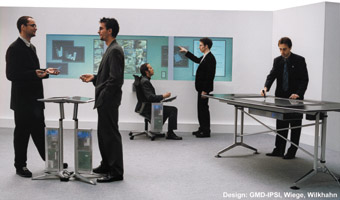
|
|
ERCIM News No.46, July 2001 [contents]
|
by Norbert A. Streitz
Roomware® consists of computer-augmented room elements with integrated information and communication technology facilitating new forms of human-computer interaction. They are part of an approach that the ‘world around us’ is the interface to information and for the cooperation of people. The Roomware® components were developed at GMD’s Integrated Publication and Information Systems Institute (IPSI) in Darmstadt.
The next generation of human-computer interaction is determined by a number of new contexts and challenges. One major challenge is to overcome the limits of desktop-based information environments currently in use. In the past, the introduction of information technology caused a shift away from real objects in the physical environment as information sources towards monitors of desktop computers at fixed places as the interfaces to information. Accordingly, user-interface designers developed the known types of human-computer interaction for the desktop paradigm. In contrast to this, we developed a new approach that emphasises again the relevance of physical objects. In this approach, the ‘world around us is the interface to information’ where traditional human-computer interaction will be transformed to human-information-interaction and human-human communication and cooperation. One result of this research are so called ‘Roomware®’ components for the Workspaces of the Future in so called ‘Cooperative Buildings’. They require new forms of interaction with information, wich are supported by the software we developed.
Roomware®
The Roomware® components were developed in the AMBIENTE-division at GMD-IPSI in Darmstadt as part of the i-LAND environment (Streitz et al, 2001). Roomware® results from the integration of information technology into room elements as, eg, walls, doors, and furniture. Roomware components are interactive and networked; some of them are mobile due to independent power supply and wireless networks, and are provided with sensing technology. The figure shows already the second generation of roomware components which was developed together with partners from industry in our R&D Consortium ‘Future Office Dynamics’. In the following, some examples of roomware are described.
 |
| The second generation of Roomware® components. |
DynaWall® and InteracTable®
The DynaWall® in the AMBIENTE-Lab is an interactive wall covering one side of the room completely. The size of 4.50 m width and 1.10 m height and the very smooth integration of this very large display into the architectural structure creates the impression that you are really writing and interacting with a wall or wallpaper. The surface is touch-sensitive so that you can write and interact on it with your bare fingers or with a normal pen (no electronics needed). Several people can write/ interact in parallel in (currently three) different areas of the DynaWall. Beyond these physical affordances, our BEACH software enables very intuitive interaction based on gestures that are reflecting actions with physical objects in the real world (eg, “take and put”, “throw”, “shuffle” , ...). When throwing objects (with different accelerations), the speed and thus the flying distance is dependent on the initial momentum provided by the user. People can interact this way immediately after having seen it once.
A similar way of interaction is provided by the InteracTable®, another roomware component we developed. It has a display size of 65 cm x 115 cm and a diameter of 130 cm. Beyond the type of interactions available at the DynaWall, it provides additional ones required by horizontal and round or oval-shaped displays. To this end, we developed in BEACH special gestures for shuffling and rotating individual information objects or groups of objects across the surface so that they orient themselves automatically. This accommodates easy viewing from all perspectives. Furthermore, one can create a second view of an object and shuffle this to the other side so that all team members have the correct view at the same time. Other examples of roomware components are the CommChairs® and the ConnecTables®. More details on the different roomware components are given in [Streitz et al (2001). Roomware: Towards the Next Generation of Human-Computer Interaction based on an Integrated Design of Real and Virtual Worlds. In: J. A. Carroll (Ed.), Human Computer Interaction in the New Millennium. Addison-Wesley].
The Passage Mechanism
Passage is a mechanism for establishing relations between physical objects and virtual information structures, thus bridging the border between the real world and the digital, virtual world. So-called Passengers (Passage-Objects) enable people to have quick and direct access to a large amount of information and to ‘carry them around’ from one location to another via physical representatives that are acting as physical ‘bookmarks’ into the virtual world. It provides an intuitive way for the ‘transportation’ of information between roomware components, eg, between offices or to and from meeting rooms.
A Passenger does not have to be a special physical object. People can turn any object into a Passenger: a watch, a ring, a pen, glasses, a wooden block, or other arbitrary objects. The only restriction Passengers have is that they can be identified by the Bridge and that they are unique. Passengers are placed on so-called Bridges, making their virtual counter parts accessible. With simple gestures the digital information can be assigned to or retrieved from the passenger via the virtual part of the Bridge. The Bridges are integrated in the environment to guarantee ubiquitous and intuitive access at every location in a building (=> Cooperative Building).
Future Work
At the beginning of 2001, we started a new project called ‘Ambient Agoras: Dynamic Information Clouds in a Hybrid World’. It is funded by the European Union as part of its proactive initiative ‘The Disappearing Computer’. ‘Ambient Agoras’ will provide situated services, place-relevant information, and a feeling of the place to the users. It aims at turning every place into a social information marketplace (= agora in Greek) of ideas and information where one can interact and cooperate with people.
Links:
http://www.future-office.de
http://www.roomware.de
http://www.Ambient-Agoras.org
Please contact:
Norbert A. Streitz — GMD
Tel: +49 6151 869 919
E-mail: streitz@darmstadt.gmd.de